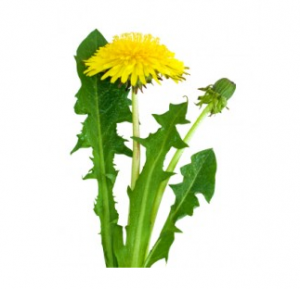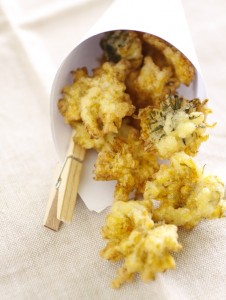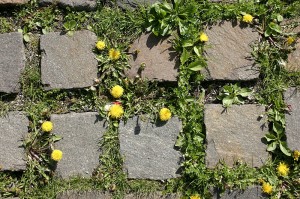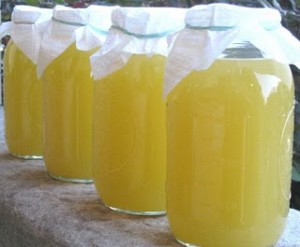 Taraxacum officinale
Taraxacum officinale
Native range: Eurasia
Invasive range: Throughout North America
Habitat: Gardens and lawns everywhere, roadsides, degraded meadows, rocky hillsides, forest openings
Identification: Tap-rooted perennial, with a rosette of oblong, deeply toothed leaves. Yellow flowers produced from May to June. Leaves, stalks, and taproot exude milky juice when cut.
Impacts: Low ecological impact with little evidence of permanent damage to native species. Considered a nuisance in disturbed areas, such as lawns.
You look out over your lawn and curse. The dandelion is back again, doing what it does best: invading. And yet it’s so common now that you may be surprised to learn it’s not a native species––it’s one of the 2,000 or so herbs brought over by European settlers, both intentionally and in pant cuffs and on boot soles: by the English to New England, by the Spanish to California and Mexico, by the French to Canada, making it easy for the dandelion to take North American swiftly.
It could be counted on to bloom early and was used to make medicines and the first wine of the new growing season. It can be counted on to spread: the seedhead is perfectly designed to be broadcast by wind; a couple of hundred seeds can, if conditions are right, be sent up to a hundred miles. The taproot, as anyone with a lawn has discovered the hard way, is difficult to remove completely since it can burrow down 10 to 15 feet––and, unless you do, is capable of continuing to send up new (tender, delicious) shoots. Among invaders, the dandelion is a fairly low threat to ecosystems.
Up until the early twentieth century, dandelions were planted in American gardens, with prizes for best-tasting greens. But then, with the rise of the suburbs and manicured lawns, the blowballs’ ratings started to fall.
The main objection seems to come from gardeners and those who like a pure green lawn. As Dr. Tom Ombrello of the Botany Department of Union County College, New Jersey, said, speaking of the strange pursuit that is gardening with nonnative species, “We create the perfect environment for weeds to get established, and then pit them against plants that are not as competitive unless we help them. Is it any wonder that the weeds, as exemplified by the dandelion, often win?”
The late great Wolfgang Oehme (1930-2011), a landscape architect known for his self-sustaining, pesticide-free gardens using grasses, perennials, and open water, celebrated his birthdays by having friends round for a “weeding party.” He enjoyed eating weeds, especially dandelions, while he worked. “I like it wild,” he was fond of saying.
Recipes
Dandelion Flower Fritters
adapted from Darina Allen’s 30 Years in Ballymaloe
Serves 4–5
For the batter
3/4 cup all-purpose flour
pinch of salt
1 organic egg
1/2 cup lukewarm water
sunflower oil,
24–30 fully open dandelion flowers
vanilla sugar, for sprinkling
First make the batter. Sift the flour and salt into a bowl. Make a well in the center, and break in the egg. Using a whisk, bring in the flour gradually from the edges, slowly adding the water at the same time.
Preheat the oil in a deep-fat fryer to 350°F or use a shallow pan with at least 1 in of oil. Shake the flowers just in case there are any insects hidden inside. Holding each flower by its stem, dip them in the batter (add a little more water or milk if the batter is too thick) and fry in the hot oil a couple at a time until puffed up and crisp—approx. 2 minutes.
Drain on paper towels. Toss in vanilla sugar and serve immediately.
Dandelion Wine
from Wines and Beers of Old New England (1978)
by Sanborn C. Brown
one gallon dandelion flowers
1 1/2 pounds sugar or honey
one cake of yeast
two lemons
The trick of making good dandelion wine is not to let the tiniest piece of stalk get into the winemaking process. Pull off the petals by holding the yellow petals with the fingers of one hand while holding the green base of the flower head with the other and then pulling the head apart. If you do not take this trouble you will get an unpleasant resinous taste in the finished wine.
Gather a gallon of heads. After removing the petals, put them in a glass jar or jug with a tightfitting lid and add three quarts of boiling water. Let this stand for seven days, stirring at least once a day. At the end of this time, strain out the petals. Boil one and one half pounds of sugar or honey in a pint of water, cool, and add to the liquor one cake of yeast and the juice of two lemons. Seal with a water lock and let it ferment for seven days. Then pour carefully into a clean jar, leaving as much of the deposit behind as you can. Boil another one and one half pounds of sugar or honey in another pint of water, cool, and add to the liquor. Ferment to completion. This double fermentation prevents the wine from becoming too sweet. When the fermentation has ceased, bottle and seal the liquor and let it age at least 6 months to a year before drinking. It has the characteristics of an after-dinner wine. It is strong (17 percent), sweet, and aromatic.
Here’s an update by Ian Knauer, one-time blogger for Gourmet:
DIY Dandelion Wine
Dandelion Salad with Warm Hazelnut Vinaigrette
Adapted from Gourmet, April 1999
Serves 6
2 large bunches dandelion greens (about 2 pounds)
1/4 cup hazelnuts
3 garlic cloves
2 tablespoons extra-virgin olive oil
1 tablespoons balsamic vinegar
Red onion and shaved Parmesan are great additions to this salad.
Discard tough stems from greens. Cut top 5 inches from dandelion leaves and reserve. Cut remaining greens into 3/4-inch slices. Transfer all greens to a large
serving bowl. Coarsely chop nuts and finely chop garlic. In a small heavy
skillet cook garlic and nuts in oil over moderate heat, stirring, until garlic is
golden. Stir in vinegar and salt and pepper to taste.
Pour hot vinaigrette over greens and toss to combine.
More Recipes
David Lebovitz’s Dandelion Pesto
Pickled Dandelion Buds Three Ways
Roasted Dandelion Root Ice Cream
Warm Dandelion and Bacon Salad
This recipe looks fantastic.





























{ 2 comments… read them below or add one }
I never curse the dandelion when I see it in my lawn – it is a noble and welcome addition and I consider it a harbinger of Spring. The yellow flowers, along with the purple of the violets, make up a lovely carpet as the weather warms.
Yes, they are edible (although a tad bitter for my taste, except when 1st year young sprouts) and yes, they are not native to NA, but I refuse to vilify them.
Pillory me for my unwelcome opinions if you must, I will continue to defend the dandelion’s honor!
Roel Boumans of Windy Acres in Vermont writes:
Dandelion Wine
Day 1: Collecting and Preparing the Wine
We make wine from 5 gallons of dandelion heads, which is quite a task. Sanborn is right about avoiding the green parts, but I would not be too anal about it, so just avoid the stems. (The green parts introduce pectin into the wine, which makes it difficult to clear.)
We add lemon or orange juice to lower the Ph and have had great success with the small frozen cans. Another approach is to add a few scoops of black tea, which introduces tannin. We like to use wine yeast rather then baker’s yeast as it is adapted to higher alcohol percentages. On sugar, the golden rule is 2.5 kilograms for ten liters of wine (or about ten pounds of sugar for five gallons of wine). So 5 gallons of dandelions need ten pounds of sugar. (Sanborn’s recipe would be sweeter than we prefer.) We boil two or three gallons of water and steep a tea from the flowers. After the solution has cooled to lukewarm, we add the yeast, tea, and lemon juice and let it ferment. We cover the bucket with a cloth to allow the maximum exchange of oxygen.
Day 7 to Day 28: Fermentation
After a week, poor the mixture though a colander into a 5-gallon carboy. Add sugar water to the halfway point in the carboy, desolving as much of the sugar as you can. All the sugar will eventually be added, but you want to do this in stages to prevent too much action in your carboy, which could result in overflowing. At this time, you want to close your bottle off with a waterlock to prevent oxygen entering and allowing carbon dioxide to leave. (You now want an anaerobic environment for the yeast.) Once the bottle is full, leave it for about two or three weeks, then remove the deposits on the bottom.
Month 1 through Year 2: Aging the Wine
Leave the bottle standing at room temperature for about 12 to 18 months, racking it every time there is a significant deposit layer. When the water lock does not show any action and the wine is clear, bottle it up and let it sit for another year to ripen.